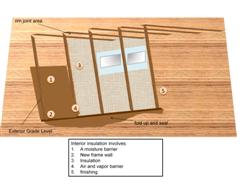Wind Barriers
A Tyvek®-style water and wind barrier that is well taped and jointed on the home’s exterior, right beneath the siding, will prevent winter winds flowing through the insulation. A lot of homeowners overlook wind infiltrating their house instead of controlling it. Though you may not feel a breeze strong enough to move your hair when the windows are closed, there may still be wind leakage. Insulation is only effective if the air within it is still. Even slight air movement in the insulation will reduce its efficiency. It’s like struggling with an umbrella when a light wind blows - wind can have the same effect on a whole house’s surface area. In a way, it’s amazing that homes don’t just blow away, since the wind exerts a force that is so strong it can penetrate insulation.
If you follow these insulation techniques, you will enjoy an extremely efficient home insulation system.
Basement Floor
This is usually a 3-inch thick (75 mm) sheet with protruding foam board insulation that has been applied on top of packed, crushed stone. On top of this is an 8-mil polyethylene moisture barrier with caulked joints and overlapping seams with acoustic sealant. This pr events moisture from the ground entering via the floor and reduces the possibility of mold. Gases like radon are also prevented from seeping through. If your foundation footing spaces do not get heavy frost, you can add a footing insulation board between the concrete slab floor and basement wall.
 Basement Walls
Basement Walls
Complete the basement walls with standard framing techniques, remembering that 2’x4’ stud walls should be set at least 4 inches (100 mm) from any concrete basement wall. This spacing leaves extra wall cavity area for more insulation without using more framing material. You can opt for cellulose or blown-in fiberglass rather than using the normal batt insulation. These insulation materials offer total coverage as well as packing density; this is also true for places that are hard to insulate such as around electrical boxes, plumbing lines and wiring.
Rim Joists
This is not some obscure medical arthritic condition - it refers to the not-so-obvious area where the exterior walls join the floor joists (called header joists or rim joists). These are especially difficult areas to insulate or even to install the vapor barrier correctly when there is so much space. Contractors don’t often make much effort here, but merely stuff some insulation inside before stapling the top with a swath of plastic.
A better alternative for rim joist insulation is to apply some spray foam material , which may be more expensive but gives great results. An extra benefit from this kind of material is that it creates the required vapor barrier.